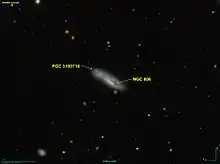| NGC 806 | |
|---|---|
 NGC 806 (SDSS) | |
| Observation data (J2000.0 epoch) | |
| Constellation | Cetus |
| Right ascension | 02h 03m 31.15s [1] |
| Declination | −09° 56′ 00.15″ [1] |
| Redshift | 0.013156 [1] |
| Heliocentric radial velocity | 3944 ± 9 km/s [1] |
| Distance | 166 Mly[2] |
| Apparent magnitude (V) | 14.10 [3] |
| Apparent magnitude (B) | 14.80 [3] |
| Characteristics | |
| Type | Scd pec? HII [1] |
| Apparent size (V) | 1.2 x 0.4 [1] |
| Other designations | |
| PGC 7835, MCG -2-6-21 | |
NGC 806 is a spiral galaxy approximately 166 million light-years away from Earth in the constellation Cetus.[1] It was discovered by American astronomer Lewis A. Swift on November 1, 1886 with the 16" refractor at Warner Observatory.[4]
Interaction with galaxy PGC 3100716

NGC 806 and PGC 3100716 (SDSS)
NGC 806 and PGC 3100716 form a pair of galaxies in gravitational interaction. These two galaxies are either colliding or are the result of a collision.[5]
PGC 3100716 is a spiral galaxy with an apparent size of 0.09 by 0.08 arcmin.[1] It was not included in the original version of the New General Catalogue, and was later added as NGC 806-2.[3]
See also
References
- 1 2 3 4 5 6 7 8 "NASA/IPAC Extragalactic Database". ned.ipac.caltech.edu. Retrieved November 29, 2017.
- ↑ An object's distance from Earth can be determined using Hubble's law: v=Ho is Hubble's constant (70±5 (km/s)/Mpc). The relative uncertainty Δd/d divided by the distance is equal to the sum of the relative uncertainties of the velocity and v=Ho
- 1 2 3 "Revised NGC Data for NGC 806". spider.seds.org. Retrieved December 9, 2017.
- ↑ "Data for NGC 806". www.astronomy-mall.com. Retrieved December 9, 2017.
- ↑ "Celestial Atlas". cseligman.com. Archived from the original on November 19, 2017. Retrieved December 2, 2017.
External links
Wikimedia Commons has media related to NGC 806.
- NGC 806 on WikiSky: DSS2, SDSS, GALEX, IRAS, Hydrogen α, X-Ray, Astrophoto, Sky Map, Articles and images
- SEDS
This article is issued from Wikipedia. The text is licensed under Creative Commons - Attribution - Sharealike. Additional terms may apply for the media files.